Emergency Supply Kits
Emergencies will strike with little or no warning. Local officials and relief workers will be on the scene after a disaster, but they cannot reach everyone immediately - you could get help within hours, or it might take days. It is critical for individuals and families to be prepared to survive on their own for at least 72 hours after an emergency. This means having food, water and other supplies in sufficient quantity for all members of your household.
Top 10 Essentials to Include in Your Emergency Supply Kit
- Water (one gallon of water per person per day)
- Food (at least a three-day supply of non-perishable food - remember pet food if applicable)
- Battery-powered or hand crank radio (and extra batteries)
- Flashlight (and extra batteries)
- First aid kit
- Wrench or pliers to turn off utilities
- Rain gear (lightweight)
- Warm clothing and/or blankets
- Comfortable/sturdy shoes
- Prescription medication supplies (if applicable)

Examples of Emergency Supply Kits
At the December 5, 2019 Los Altos PREPARES Inspiration Session meeting, local volunteers shared their Go-bags and emergency preparedness supply kits and discussed their choices of contents. This information is compiled here for your reference. We hope it inspires you to build, update, or add to your own kits!
- WUSH Bag (“Wake Up, Something’s Happening”)—grab this bag on your way out the door when you need to evacuate immediately.
- Home Evacuation Bag—grab this bag of supplies when you evacuate your home, and have the time to get it.
- Home Emergency Preparedness Supplies—you should have a cache of supplies stored at your home: Food and water (1 gallon per person, per day) for your family for at least 3 days and better yet, for 7 days. Other supplies that you’d need to shelter in your home after a disaster.
- Neighborhood Medical Kit—an example of supplies your neighborhood may need to treat injuries after a disaster event. (Coming Soon) View a recorded webinar presented by Victoria Beebe of the Los Altos Hills County Fire District teaching about the Family First-Aid Bag, its contents and use.
- CERT Go-Bag—Community Emergency Preparedness Team members need to carry some supplies for themselves and for their CERT role.
- Ham Go-Bag—Amateur Radio operators providing emergency communications support need to carry some supplies for themselves and their communications capabilities.
- Pet Emergency Supplies—Whatever type of pet you have, be sure to store emergency food, water and supplies and to have a plan for your pet. While cats and dogs may be able to go to a human emergency shelter, other pets (livestock, reptiles, rodents, exotic pets, etc.) will need a plan specific to them.
- Car Kit—Since we don’t know when emergency events may occur, you should keep some supplies in your car that help with “regular car emergencies” as well as for disasters.
- Emergency Food Kit—Girl Scout Troop 60302 evaluated requirements and options for an emergency food supply.
Additional Resources
Find more resources to help you build an effective emergency supply kit at the following websites:
- 24-Week plan to gradually build up your emergency supplies (PDF), from Campbell CERT
- 72 Hour Emergency Preparedness
- City of Los Altos Emergency Supplies Kit (PDF)
- City of Los Altos Emergency Supplies Guide (Slides)
- Cal EMA Preparedness Tips - Emergency Supplies (PDF)
- FEMA Build a Basic Disaster Supplies Kit
- FEMA Preparedness for Pets (PDF)

